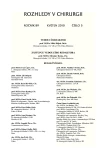Neurogenic Bladder Therapy in Patients with Spinal Dysraphism. Actual Strategy
Authors:
P. Zerhau; M. Husár
Authors‘ workplace:
Urologický úsek KDCHOT FN Brno, přednosta: prof. MUDr. P. Gál, Ph. D., MBA
Published in:
Rozhl. Chir., 2010, roč. 89, č. 5, s. 306-309.
Category:
Monothematic special - Original
Overview
Purpose:
Retrospective evaluation of conservative and surgical treatment of detrusor hyperactivity in patients with spinal dysraphisms having been observed in our clinic during the last 20 years.
Material and method:
In the period 1989/2009, 87 patients in the age between 0 and 35 years suffering from the above disease were monitored. The period was divided into three terms. Term I: 1989/1995, Term II: 1996/2005, Term III: 2006/2009. 28 patients were followed-up in the Term I, 58 patients in the Term II and 69 patients in the Term III. The applied types of therapy (conservative, surgical, mini-invasive methods) were specified within the mentioned patients’ groups and substitution alterations were monitored.
Results:
54 patients were treated conservatively, 33 patients underwent an operation. During the Term I, 23 of the total 28 patients were treated conservatively, 5 (17.9%) patients were operated (3x ileocecal replacement, 2x ileocystoplasty). In Term II, 58 patients were treated, 23 (39.7%) thereof were operated (18x ileocystoplasty, 4x gastrocystoplasty, 1x sigmoideocystoplasty). In the Term III, 69 patients were followed-up and treated, 5 (7.2%) of them were operated (3x ileocystoplasty, 1x gastrocystoplasty, 1x sigmoideocystoplasty), and other 5 (7.2%) underwent a mini-invasive procedure by Botulinumtoxin A application.
Key words:
spinal dysraphisms – neurogenic urinary bladder – dyssynergy – augmentation – botulinumtoxin A
Sources
1. Raezer, D. M., Benson, G. S., Wein, A. J., Duckett, J. W. Jr. The functional approach to the management of the pediatric neuropathic bladder: a clinical study. J. Urol., 1977, May; 117(5): 649–654.
2. Hensle, T. W., Burbige, K. A. Bladder replacement in children and young adults. Urol., 1985, Jun; 133(6): 1004–1010.
3. Robertson, C. N., King, L. R. Bladder substitution in children. Urol. Clin. North. Am., 1986, May;13(2): 333–344.
4. Lendvay, T. S., Cowan, C. A., Mitchell, M. M., Joyner, B. D., Grady, R. W. Augmentation cystoplasty rates at children hospitals in the United States: a pediatric health information system database study. J. Urol., 2006 Oct;176(4 Pt 2): 1716–1720.
5. Jarolim, L., Babjuk, M., Hanus, T., Jansky, M., Skrivanova, V. Orthotopic reconstruction of the urinary bladder with preservation of urethral function in women after cystectomy. Rozhl. Chir., 1996, Apr; 75(4): 222–226.
6. Jarolim, L. The continent ileocecal pouch (Mainz Pouch). Rozhl. Chir., 1988, Oct; 67(10): 625–632.
7. MacLellan, L. D. Management of pediatric neurogenic bladder. Current opinion in urology, 2009, 19: 407–411.
8. Krhut, J., Maixner, K., Kopecký, J. Botulotoxin A – alternativa v léčbě hyperaktivního měchýře. Čes. Urol., 2, 2004, 19.
9. De Jong, T. P. V., Chrzan, R., Klijn, A. J. Treatment of the neurogenic bladder in spina bifida. Pediatr. Nephrol., 2008, 23: 889–896.
Labels
Surgery Orthopaedics Trauma surgeryArticle was published in
Perspectives in Surgery

2010 Issue 5
Most read in this issue
- The Role of Hartmann’s Procedure and Options for its Reconstruction at the Present Time
- Buried Bumper Syndrome (BBS) as a Complication of Percutaneous Endoscopic Gastrostomy
- Komplikace hojení ran u kuřáků
- Neurogenic Bladder Therapy in Patients with Spinal Dysraphism. Actual Strategy
